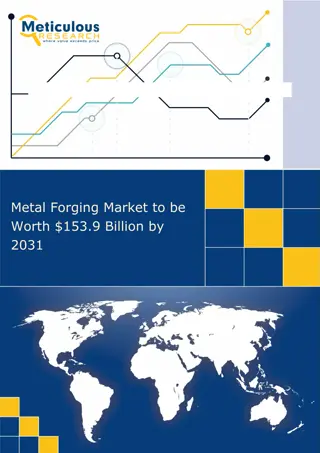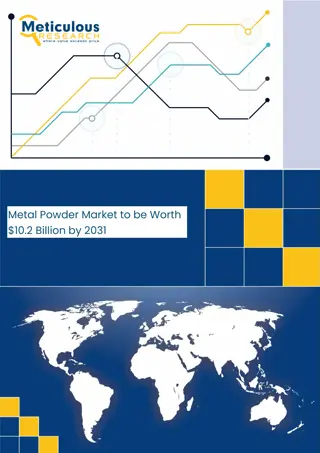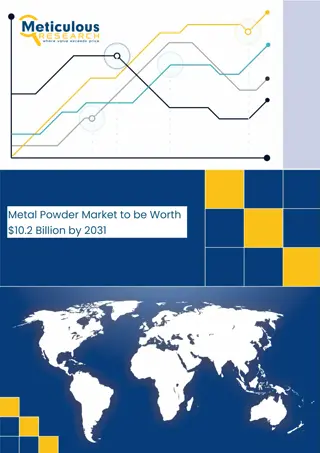Powder Rolling, Extrusion, and Forging in Metal Processing
Metal powders can be processed through powder rolling, extrusion, and forging techniques in the field of powder metallurgy. Powder rolling involves compressing powders into metal strip stock using rolling mills, followed by sintering and cold rolling. Powder extrusion, on the other hand, utilizes a plastificator to form products like rods or tubes through pressing. These processes are vital for materials like high-temperature alloys, ceramics, and cemented carbides. The extrusion technology allows for the production of advanced materials with specific properties.
Download Presentation

Please find below an Image/Link to download the presentation.
The content on the website is provided AS IS for your information and personal use only. It may not be sold, licensed, or shared on other websites without obtaining consent from the author.If you encounter any issues during the download, it is possible that the publisher has removed the file from their server.
You are allowed to download the files provided on this website for personal or commercial use, subject to the condition that they are used lawfully. All files are the property of their respective owners.
The content on the website is provided AS IS for your information and personal use only. It may not be sold, licensed, or shared on other websites without obtaining consent from the author.
E N D
Presentation Transcript
Powder Rolling, Extrusion, and Forging Powder Rolling Powders can be compressed in a rolling mill operation to form metal strip stock. The process is usually set up to run continuously or semi continuously, as shown in figure (1). The metallic powders are compacted between rolls into a green strip that is fed directly into a sintering furnace. It is then cold rolled and resintered.
Figure (1): Powder rolling: (1) powders are fed through compaction rolls to form a green strip; (2) sintering; (3) cold rolling; and (4) resintering.
Processes occurring during powder rolling are shown in Fig. 2. In a region 1, there is a non- compacted loose powder material. When passing into the second zone, characterized by an angle a, the compacting process induced by friction between contra-rotating rolls and powder particles starts to be performed. The applied forces reach the maximum values in the narrowest point between the rolls. In contrast to rolling of compact materials, the acting pressure increases slowly atfirst. Figure (2) Powder in the rolling gap: region 1 non-compacted powder, region 2 zone of powder compaction
Powder Extrusion This is a procedure of metal powder compaction or semi- products, manufactured by pre- pressing, or possibly by pre-sintering, in a continuous strand. The process can be carried out at a normal or elevated temperature (sintering temperature). In the case of extrusion pressing at room temperature, a mixture of powder and a plastificator is pressed through a nozzle into rods or tubular forms. A plastificator is an additive, usually an organic substance (e.g. wax, methylcellulose, synthetic resin, etc.), which is added to metal powders in order to form a plastic pasty material suitable for forming. A principle scheme of the direct and undirect way of extrusion is shown in Fig. 4.
Figure (4) Extrusion methods: a) undirect extrusion; b) direct extrusion.
The extrusion technology is used for all materials which can be processed using powder metallurgy procedures. These are cemented carbides, high-temperature materials with high hardness and especially technical ceramics. A pressing mixture contains 20 30 % of a plastificator which has to be removed prior to the actual sintering. The compacting pressure is performed using e.g. a piston or a screw. Fine powders require higher pressures than for coarse powders extrusion, because more joints occur, which are fractured and welded repeatedly during the process. A schematic depiction of a powder material extrusion machine is shown in Fig. 5.
Figure (5) Schematic depiction of the powder material extrusion machine
Powder Forging Forging is an important metal forming process. In powder forging, the starting workpart is a powder metallurgy part preformed to proper size by pressing and sintering. Advantages of this approach are: (1) densification of the PM part, (2) lower tooling costs and fewer forging hits (and therefore higher production rate) because the starting workpart is preformed, and (3) reduced material waste.
This technology combines powder metallurgy advantages with die forging processes. This way quite complicated shapes with high density (up to 99.5 %) and product accuracy can be produced (Fig. 6). In general, either forging of a non-sintered compact (i.e. powder forging) or of a sintered compact, mostly in a hot protective atmosphere, can be performed. Technological operations of forging: preparation of a powder mixture mixing of powder metal with pressing additives (lubricants, graphite, etc.); pressing of preforms; heating in order to remove lubricant under a protective atmosphere; sintering (in the case of a sintered compact forging); forging; finishing operations (heat treatment, smoothing etc.).























